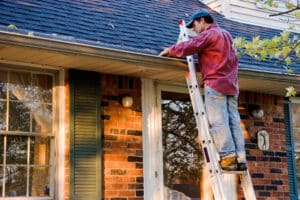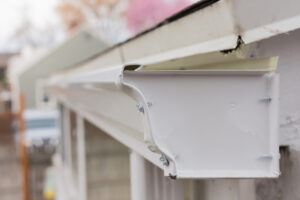Most people only think of the roofing material when the word “roof” is mentioned. It is the most visual part of the roof and covers all the other components. It acts as the first line of defense against sunlight, rain, wind, hail, snow, and other damaging elements.
Shingles are the Most Popular Roofing Material
The most common roofing material you see on homes today is the asphalt shingle. This roofing material consists of individual overlapping elements, usually flat and rectangular. Shingles are laid in rows from the bottom edge and up to the roof’s peak, each course overlapping the one below.
The materials are nailed to the roof deck. The overlapping helps prevent them from lifting when there’s a wind storm and ensures that water doesn’t move into the spaces between the shingles. Heat-activated adhesives also provide extra reassurance that the shingles will not detach from the roof.
The roofing material is installed above the other components and should not be seen from the attic. Your shingles should lie flat against the roof. They’ll need to be repaired or replaced if they’re cracked, missing, buckling, curling, damaged, leaking, or bald (due to excessive granule loss).
The Importance of Your Roofing Material
Protection from the Elements
Shingle roofing provides an attractive and durable choice to protect your home from nature’s elements. The material is designed to withstand most of what Mother Nature throws at it – wind, rain, hail, snow, heat from the sun, and hail damage.
Think of your roof covering as your home’s umbrella. It will protect your home and everything in it from the elements.
Aesthetic Beauty
Your roofing material can influence the entire look or style of your home. Shingles, for instance, are available in a wide array of colors, with tones ranging from classic black and gray to blue-green, brown, and beige. The colors are matched to your siding and other exterior features to fit in with the architectural design.
Also, shingles can be designed to mimic the look of wood shake, slate, or tile to embrace a sense of elegance or give a vintage appearance to a historic home. They’re available in different shapes and can be laid in different styles. When the right choice is made, your roof covering will help add curb appeal to your home.
Energy Efficiency
Your roofing material offers a level of energy efficiency favorable for the attic space and the surface of the roof deck. A light color roofing material will reflect the heat away from the roof surface, reducing the amount of heat absorbed into your home.
Important Terms Related to the Roofing Material
Drip Edge
A drip edge is an angled piece of metal flashing installed at the roof’s edge and on top of a fascia board. It lies beneath the roofing material. A drip edge is waterproof and made of non-staining and non-corroding materials such as aluminum, copper, and steel.
The drip edge helps protect your home and prolong the lifespan of your roof. Here are the protective advantages of a drip edge.
- Directs water away from the roof and the fascia and into the gutter.
- Prevents water from damaging your roof decking and fascia board.
- Seals the gap between the decking and fascia board, keeping pests out of your attic.
- Stabilizes your roof during strong winds and rain by preventing movement between the deck boards and fascia.
- Assists gutters to easily direct water away from your home’s foundation.
- Provides extra protection for your roofline during the winter.
- Provides backup protection if shingles fail, especially in wintry or stormy weather.
Granules
Granules are small bits applied on the shingle’s top surface. Hard rock is crushed to exact granular size specifications during the shingle manufacturing process, and then the granules are embedded into the hot asphalt. This gives shingles a motley, rough appearance.
The granules give asphalt shingles their color as well as their reflective properties. Some shingles have special algae-resistant granules, which help prevent discoloration by blue-green algae.
Roofing granules serve several purposes:
- UV protection: Granules protect against the sun’s harsh UV rays and extreme temperature changes. The granules limit the amount of heat absorbed by shingles, reducing the chances of curling or warping.
- Aesthetic appeal: Granules create a distinct texture and add color to the shingles, enhancing the overall look of the roof’s surface.
- Durability: They help ensure your roofing material’s lasting performance.
Square
A roofing square is a standardized measurement for calculating the size of a roof. A roofing square is equal to 100 square feet of roof surface. The unit is used by roofing contractors to determine the amount of roofing material they’ll need to order for your project.
Adam Vaillancourt Roofing Only Works With the Highest Quality Materials
Adam Vaillancourt Roofing is a premier roofing contractor in the Southern New Hampshire and Northern Massachusetts area. We specialize in shingle roofing and hold the highest credentials awarded by CertainTeed and Owens Corning. We can help you choose the best roofing material for your home and provide quality roof replacement, repair, and maintenance services. Contact us today to discuss your next project.




